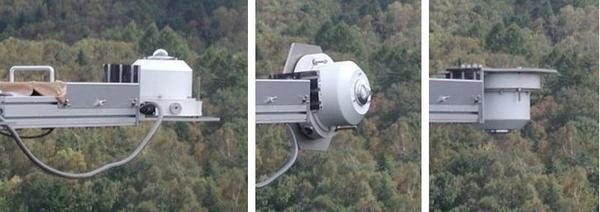Satellite remote sensing (RS) is a strong methodology in the study of terrestrial ecosystems. For example, RS is used in scaling up of the ground measurements of carbon flux, water flux, biomass, etc. from a site scale to a regional or global scale. RS provides numerical regional ecological models with information for initial conditions, boundary conditions, and validation. For the sake of it, various new satellite sensors have been designed and launched. They are now delivering a lot of high-level products regarding to the terrestrial ecology, such as new vegetation indices, LAI, FPAR, phenology, GPP, and NPP.
However, in the ecological standpoint, these RS methodology has not enough checked or validated on the ground level. Because an essential characteristics of ecosystem is its dynamism (especially the seasonal change, or "phenology"), the accuracy, quality, and interpretation of the RS data should be also studied dynamically. For the sake of it, a stable, continuous, long-term, and multi-ecosystem ground validation network is desired. Of course, the flux observation networks such as AsiaFlux have potential to contribute to it. However, because RS observes vegetation's optical characteristics rather than carbon or heat flux, we need to include optical (spectral) observation in the validation of ecological RS. We believe that the ecological interpretation of RS data is possible only if it is based on a careful theoretical and experimental study of the relationships between optical characteristics and ecological structure (or function), using the quality-controlled RS data considering the relevant noise factors such as cloud contamination or atmospheric aerosols.
With this background stated above, we have started the "Phenological Eyes Network (PEN; Tsuchida et al., 2005; Nasahara and Nagai, 2015)." PEN is a network of ground observatories for long-term automatic observation of the vegetation dynamics (phenology), vegetation's optical properties (such as spectral reflectance), and the atmospheric optical properties (such as aerosol optical thickness). Most PEN ground sites have been set up at the AsiaFlux sites. The collaboration of PEN and AsiaFlux is critically important in the interpretation of the optical signals captured by RS in terms of ecology (especially the terrestrial carbon/water cycles).
気候変動に伴う生態環境 (生物多様性) の異変をとらえるために、衛星リモートセンシングへの期待が高まっている。そのため、さまざまな衛星センサーが新しく開発・運用され、それを利用して、植生指標の改良や、LAI (葉面積指数) ・FPAR (光合成有効放射吸収率) ・GPP (純一次生産量) などの生物物理量の推定手法の開発が進んでいる。
ところが、このような生態系の衛星リモートセンシングに対して、検証のための系統的なデータは少ない。それには、陸上生態系は不均一性が著しいために、上記のような量を衛星観測のピクセルに対応できるくらいに大きなスケールで地上観測することが難しいということが一因であり、また、LAIなどは地上観測手法自体がまだ確立されていないということも一因だろう。しかしながら、最大の問題は、地上生態系の絶え間ない変動に追随するには、安定した長期・連続的な観測システムが、しかも多点で必要であるということである。特に、植生の季節変動 (フェノロジー) は、生態環境の変動として顕著な特徴である上に、陸上生態系モデルにも重要であり、なおかつ衛星観測可能性が比較的高い情報だが、それらを生態学的な観点でしっかりと地上検証できるデータは乏しい。
これにわずかでも応えるため、陸上植生の季節変動・長期変動に関する長期観測網"Phenological Eyes Network (PEN)"を展開してきた (土田ら, 2005; Nasahara and Nagai, 2015) 。PENは、基本的な植生状態・分光特性・大気状態 (エアロゾル等) のそれぞれの変動を定性的・定量的に長期自動観測する一方で、陸上植生の炭素収支観測網"AsiaFlux"と共同し、炭素循環・水循環の基本的な観測と結合できるような体性を目指している。さらに、LAIや入射PAR・透過PAR、個葉の特性 (光合成生理、分光特性) 、樹冠構造などに関する観測も行っている。これらに基づいて、植生の変動を、SVATモデルや放射伝達モデルで追跡・再現することにも取り組んでいる。
Because the goal of PEN is to collect long-term quality-controlled multi-site data, the main instruments should be stable, robust, and low-cost. Based on this principle, we selected and designed the following three types of instruments: the Automatic-capturing Digital Fisheye Camera (ADFC), the HemiSpherical Spectro-Radiometer (HSSR), and the sunphotometer (SP).
観測機器については、限られた予算でより多くの地点・サイトで観測するために、自動撮像型魚眼デジタルカメラ・半球分光放射計・サンフォトメータをPEN用に改造・開発した。また、必要
に応じ機器補正を行い、より高度なパラメータの取得を目指した。
ADFC (Automatic-capturing Digital Fisheye Camera)
ADFC is a combination of a high-quality digital camera (Nikon CoolPix series), a fish-eye lens (Nikon FC-E8), a water-proof housing case, and a control system with a personal computer. It captures images of the sky, the canopy from above and below, the forest floor, and shoots of typical species with short intervals (2 minutes to 24 hours, depending on the target). These images provides information about cloud condition at the satellite's observation, vegetation phenology, snow pack, tree cover, and LAI.
自動撮像型魚眼デジタルカメラ(ADFC: Automatic-capturing Digital Fisheye Camera)は、天空 (数分おき) ・林冠・林床 (数時間おき) などを対象とし、Nikon Coolpix 4300および4500をパソコン又は専用リモートコードで制御している。フェノロジー・衛星飛来時の雲被覆・LAIなどを得ている。

HSSR (HemiSpherical Spectro-Radiometer)
HSSR is a hyper-spectral radiometer in the visible and near-infrared region (MS-700 of Eko Instruments Co. or PGP-100 of Prede Co.). In order to catch both incoming and reflecting radiation with a single radiometer, we developed a computer-controlled rotating stage in collaboration with Hayasaka Rikoh Co. If the HSSR is mounted on the rotating stage, it can be directed upward and downward consecutively with a short interval of time at a same position. Thus we can obtain the spectral features of the vegetation canopy with fine-temporal and fine-spectral resolution. By using such data, we can check the spectral observation of RS. Moreover, we can simulate various types of spectral indices (such as NDVI, EVI, PRI) with arbitrary spectral response of every specific satellite sensors.
半球分光放射計(HSSR: HemiSpherical Spectro-Radiometer)は、英弘精機の可視分光放射計MS-700かプリードの全天分光日射計PGP-100を、新たに開発した放射計自動回転装置 (早坂理工にて製品化、クリマテックにて販売。CHS-AR01) に装着、上方と下方からの分光放射を1台の分光放射計で測るようにしている。衛星植生指標(NDVI, EVI, PRIなど)や放射伝達モデルの検証に用いる。

SP (sun photometer)
SP is a spectral radiometer with a small field-of-view and pointing functionality. We use POM-02 of Prede Co. We can estimate optical properties of the atmosphere which are needed for atmospheric correction of the RS data. It can provide quantitative information about atmospheric pollution or aerosol dust (such as the Yellow Sands), both of which may have some direct or indirect impacts on the ecosystems.
サンフォトメータ(SP: SunPhotometer)は、プリードのスカイラジオメータを利用している。衛星データ大気補正に必要な、複素屈折率や光学的厚さ、粒径分布などを得る。

Other measurements
In addition to the above-mentioned main instruments, in some sites, we are making observation of environmental ecophysiological properties including incoming PAR (direct and diffuse), transmitting PAR, leaf phenology, LAI (LAI-2000, fisheye image, laser profiler, and litter trap), leaf-level optics, leaf-level physiology (LI-6400, pigments, C/N, LMA).
以上に加えて、樹冠上下にシリコン製PARセンサー(小糸、プリード、英弘精機、Li-Corなど)を設置して、反射PAR・透過PARを観測することでFPARをモニタリングしている。また、魚眼デジタルカメラによって多点での林冠写真を定期的に撮影することでLAIの空間分布を評価したり、キャノピーアナライザー(LAI-2000やTRAC)を用いてLAIのクロスチェックを行っている。定期的に葉の分光反射・透過特性やSPAD値を測定し、サンプリングによって色素量やC/N比、水分量、比表面積なども計測している。背景土壌の分光観測も、携帯型分光計によって不定期に実施している。
Details on the system (in Japanese) 観測システムの詳細
1. Concept, Development and Management
 phenology / フェノロジー
phenology / フェノロジー cloud coverage / 被雲率
cloud coverage / 被雲率 photosynthesis / 光合成 (LUE, FPAR and PAR)
photosynthesis / 光合成 (LUE, FPAR and PAR)  leaf area index / 葉面積指数 (LAI)
leaf area index / 葉面積指数 (LAI) validation, calibration, and assimilation of satellite data / 衛星データ検証・校正・同化
validation, calibration, and assimilation of satellite data / 衛星データ検証・校正・同化 spectral vegetation index / 分光植生指標 (NDVI, EVI, PRI, ...)
spectral vegetation index / 分光植生指標 (NDVI, EVI, PRI, ...) spectral radiation / 分光放射
spectral radiation / 分光放射 radiative transfer / 放射伝達
radiative transfer / 放射伝達 carbon, water, energy cycle / 炭素・水循環
carbon, water, energy cycle / 炭素・水循環



 開発・観測メンバー (50音順) 及び主な協力項目.(2007/02/10まで; 所属や氏名は当時のまま)
開発・観測メンバー (50音順) 及び主な協力項目.(2007/02/10まで; 所属や氏名は当時のまま)